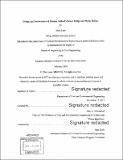Design and performance of Thomas Telford's Bonar Bridge and Mythe Bridge
Author(s)
Lane, Ellen (Ellen Philippa)
DownloadFull printable version (31.88Mb)
Other Contributors
Massachusetts Institute of Technology. Department of Civil and Environmental Engineering.
Advisor
John A. Ochsendorf.
Terms of use
Metadata
Show full item recordAbstract
This paper assesses two cast-iron arch bridges of Thomas Telford (1757-1834) - Bonar Bridge (1810-12) and Mythe Bridge (1824-26) - to draw a broader conclusion about his career in bridge building. The bridges are introduced and Telford's design influences are investigated. While Telford was influenced by theory through the advice of his contemporaries, he was more heavily influenced by experience, especially design precedents, and most of all by his own judgment, which placed great emphasis on both practicality and aesthetics. The structural performance of the two bridges is assessed and compared. The cast-iron arch's ability to resist vertical loading is the main focus of the analysis, following Heyman's framework for limit analysis of arches. Global equilibrium and graphic statics indicate that the each rib, when acting alone, is insufficient to support asymmetric loading, demonstrating that the secondary members are necessary, and therefore that neither bridge is grossly overdesigned. Deck-stiffening effects are tested following Billington's method, and are found to be negligible. The spandrel bracing members are found to be sufficient apart from the development of tension forces in Bonar Bridge. The later Mythe Bridge performs slightly better in all areas; overall, however, the performance is very similar. Based on these results, the paper concludes that Telford chose not to refine his design substantially over the course of his career. It is argued that this was a conscious decision, based on the progression of the industry from cast iron towards wrought iron, and that these bridges are significant because they bookend the short golden age of cast iron bridges, of which Telford was the unquestionable master.
Description
Thesis: M. Eng., Massachusetts Institute of Technology, Department of Civil and Environmental Engineering, 2018. Cataloged from PDF version of thesis. Includes bibliographical references (pages 107-113).
Date issued
2018Department
Massachusetts Institute of Technology. Department of Civil and Environmental EngineeringPublisher
Massachusetts Institute of Technology
Keywords
Civil and Environmental Engineering.